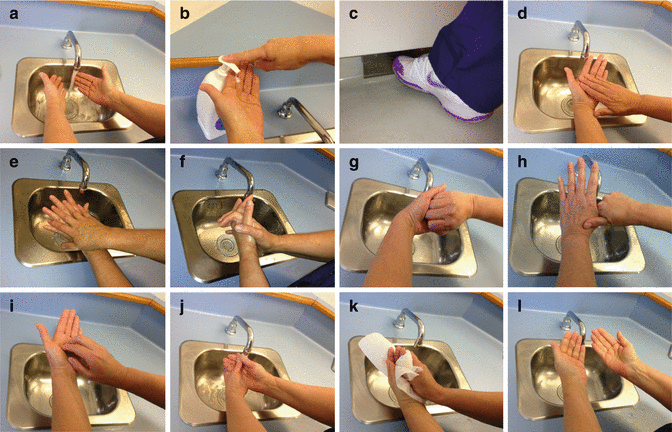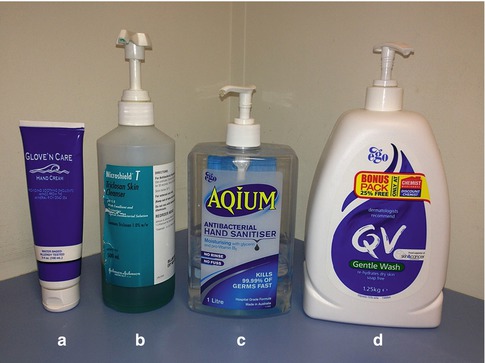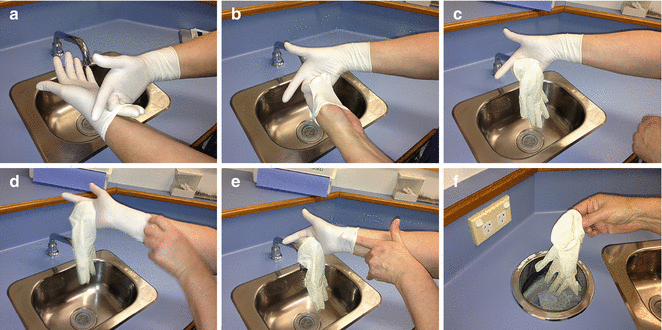(1)
Canberra, ACT, Australia
Summary
The adherence to strict infection control procedures helps to protect practitioners, patients and the community. Implementation of universal cross-infection precautions and practices within a health-care setting prevents transmission of HIV, HBV and HCV. Vaccination is an important infection control strategy for HBV and HAV. All health-care workers should be aware of their immune status and vaccinated accordingly. Dental practitioners are aided in this process by the generation of rules, guidelines and recommendations by regulatory services and professional organisations within their jurisdiction or country of residence.
Clinical Relevance
Clinicians must adhere to universal cross-infection procedures to prevent the risk of transmission of pathogens to patients. Personal hygiene practices including hand washing, use of personal protective equipment, safe disposable systems for sharps and contaminated waste, adequate cleaning, disinfection and sterilisation procedures must be adhered to according to strict guidelines outlined. Endodontic practice and the adoption of single-use instruments have been highlighted due to concerns with prion disease and the inability to adequately sterilise such instruments.
7.1 Overview of Infection Control and Standard Precautions
The prevention of transmission of potentially pathogenic microorganisms from all blood and body substances necessitates the implantation of vigorous infection control practices and policies. Universal precautions in the dental setting ensure a high level of protection against the transmission of pathogenic organisms with minimal stigma and discrimination to patients. The implementation of strict hand hygiene procedures, use of personal protective equipment (gloves, masks, clinical attire, protective eyewear), immunizations and standard recommended sterilisation and disinfection procedures are applied to all patients regardless of information or assumptions made about a patient’s infection status [1].
Routine hand hygiene is essential in preventing the spread of infection and is considered to be the single most important infection prevention strategy in health care and also the simplest. It must be performed before and after every episode of patient contact using alcohol-based hand rubs that contain between 60 and 80 % v/v ethanol or equivalent. Plain soaps act by mechanical removal with no antimicrobial activity. They are sufficient for general social contact and for cleaning very soiled hands. Effective hand hygiene relies on an appropriate technique as well as selection of the correct product. Strict guidelines should be adhered to in relation to cuts, abrasions, fingernails, nail polish and jewellery [2–10].
Employers are responsible for providing appropriate personal protective equipment in the workplace. A surgical mask and protective eyewear must be worn during procedures that generate splash or sprays with blood, body substances, secretions or excretions into the face and eyes. Single-use gloves are recommended for each invasive procedure and must be changed between patients and after every episode of individual patient care. Latex allergy is a reaction to certain proteins in latex rubber, which can cause sensitization in health-care workers. Latex gloves should be non-powdered due to the risks associated with aerosolisation and an increased risk of latex allergies. Alternative non-latex gloves should be available for the use of both health-care workers and patients with known latex allergies. Sterile gloves must be used for aseptic procedures such as surgical endodontics. Suitable footwear should be worn preferably designed with closed toes to minimise the risk of injury from dropped sharps. Uniforms should be recommended in areas of clinical practice where there is a high risk of repeated exposure to blood and other body substances and washed on a daily basis [11–18].
The use of sharps devices exposes health-care workers to the risk of injury and potential exposure to blood-borne infectious agents including hepatitis B virus (HBV), hepatitis C virus (HCV) and human immunodeficiency virus (HIV). All health-care workers should take standard precautions to prevent injuries caused by needles, scalpels and other sharps instruments or devices during procedures, during disposal of used needles and when handling sharps instruments during procedures and when cleaning used instruments. Any person who has used a disposable sharps instrument or equipment must be responsible for its safe management and immediate disposal after use. Sharps must not be passed directly from hand to hand, and handling should be kept to a minimum. Needles must not be recapped, bent or broken after use. Approved sharps containers must be present, preferably at the point of use, and must not be filled above the mark indicating that the bin is three quarters full [19–26].
Vaccination is an important infection control strategy for the prevention of transmission of HBV, measles, mumps, rubella, pertussis, tuberculosis and chicken pox (varicella) within the clinical setting. All health-care workers should ensure that adequate levels of protection are maintained by awareness of their immune status and appropriate vaccination and booster immunizations where necessary [13, 27–30].
Infectious agents can be widely found in the health-care setting, and there is a body of clinical evidence, derived from case reports and outbreak investigations, suggesting an association between poor environmental hygiene and the transmission of infectious agents. Transmission of infectious agents can occur directly through contaminated clinical equipment or indirectly when touching patients via hands that come into contact with contaminated equipment or the environment. Minimal hand contact surfaces such as floors should be routinely cleaned when visibly soiled and immediately after any spillage has occurred. Frequently touched surfaces within the clinical environment (clinical contact surfaces) should be cleaned with suitable detergent solution at least daily, when visibly soiled and after every known contamination. Clean touched surfaces of shared clinical equipment should be routinely cleaned between patients using suitable detergent. Surface barriers are recommended to protect the clinical environment particularly where equipment is touched frequently with gloved hands during patient care delivery, surfaces that are likely to be contaminated with blood or bodily substances or areas that are difficult to clean. Site decontamination after spillage of blood or other potentially infectious materials is recommended using suitable gloves and personal protective equipment. The spillage should be confined and contained and any visible matter cleaned using absorbent disposable material that is discarded appropriately after use. Detergent solution should be used [31–36].
All contaminated instruments must be disinfected and sterilised according to the degree of risk of infection involved in the use of these items (critical, semi-critical and noncritical). Critical items confer a high risk of infection if they are contaminated with any microorganism and must be sterile at time of reuse. Manual cleaning of critical and semi-critical instruments, in order to remove organic material, must always precede high-level disinfection and sterilisation, thereby increasing its effectiveness. Automated cleaners such as ultrasonic cleaners and washer-disinfectors reduce the handling of instruments and are recommended. Manufacture recommendations must be adhered to when selecting appropriate cleaning solutions for particular instruments. Neutral pH or mildly alkaline solutions generally provide the best material compatibility compared to acidic solutions that may damage instruments. Enzyme cleaners such as proteases may be added to assist in removal of organic material such as blood and pus. Lipases (active on fats) and amylases (active on starches) are also recommended. Specific test methods to check the effectiveness and verify the cleaning processes of manual and automated processes are recommended. Visual inspection with magnification where possible should be the minimum step to ensure satisfactory cleaning prior to disinfection and sterilisation.
Disinfection is a process that inactivates non-sporing infectious agents using either thermal (moist or dry heat) or chemical (alcohols, chlorine, formaldehyde, hydrogen peroxide, phenolics and quaternary compounds) means. Items need to be cleaned prior to disinfection and are not a replacement for sterilisation.
Sterilisation destroys all microorganisms on the surface of an instrument or device to prevent disease transmission associated with that item. Reprocessing of heat-resistant items is recommended by steam sterilisation due to the safety margin, reliability, validity and lethality. The user must validate the sterilisation process, and all records must be kept. All sterilised items must be stored in a way that ensures that the level of reprocessing is maintained. Dry, sterile, packaged instruments and equipment should be stored in a clean, dry environment and protected from sharp objects that may damage the packaging [37–40].
Dental unit water systems harbour bacterial biofilms, which may serve as a haven for pathogens. The reservoir of bacteria within the dental unit water lines (DUWL) carries the potential to infect patients and dental workers alike. Maintaining drinking water standard in the DUWL by incorporating independent bottled sterile water, automatic treatment systems, antibacterial filters, antimicrobial tubing, anti-retraction valves and chemical flushing of the units on a daily basis should be an integral component of dental surgery infection control and quality assurance. Sterile water or saline should be used for all endodontic surgical procedures [41–44].
After use, endodontic stainless steel files and rotary instruments that are to be reused should be kept in moist storage whilst awaiting the cleaning process. Sequential combined mechanical (brushing) and chemical-cleaning (ultrasonic bath and sodium hypochlorite solution) procedures will greatly reduce the organic debris located on the flutes of instruments. The removal or organic debris prior to heat sterilisation theoretically reduces the bioburden and increases the assurance that the sterility process is effective in minimising cross-contamination and infection [45–48].
The recognition of prions as infectious agents in humans has caused significant concern amongst the public and medical/dental professionals alike. Creutzfeldt–Jakob disease (CJD) in humans has been shown to be transmissible via several routes, including transplantation, contaminated medical products and neurosurgery. Whilst the likelihood of transmission in dentistry is undoubtedly very low, this may be amplified considerably by unknown risk factors, such as disease prevalence (particularly in the UK) and the failure of routine recommended decontamination protocols currently used in dental practice to inactivate prions adequately. Cleaning, disinfection and steam sterilisation are not recommended for reprocessing of items potentially contaminated with prions such as vCJD. Single-use items should be used wherever possible and subsequently destroyed by incineration. In light of these findings, the UK Department of Health has advised dentists to ensure that endodontic reamers and files are treated as single use as a precaution, to reduce any potential risk of vCJD transmission. In all patients suspected of CJD or those awaiting neurological diagnosis, the mandatory use of single-use items and subsequent removal from service and storage in a secure facility is standard protocol. The application of universal precautions and implementation of the use of single nonreusable equipment would theoretically prevent cross-contamination of all potential pathogens including prions but financially would be unsustainable and impossible. Current guidelines continue to recommend strict adherence to cross-infection policy and practices adopting universal precautions for all patients to assure the best practice [49–60].
7.2 Hand Hygiene
Hand hygiene is one of the simplest methods in preventing the spread of infection and is considered to be the single most important infection prevention policy in health care. Microorganisms are usually present on the hands most of the time (resident flora) or acquired during the treatment of patients (transient). The act of hand washing using soap and water is typically acceptable as a means of social hand hygiene. Within the clinical setting the decontamination of hands using antibacterial-based rubs or gels is categorised as hygienic hand decontamination necessary to prevent cross-transmission of infectious agents. Surgical scrubbing including the decontamination of hands and forearms aims to remove both resident and transient flora prior to any planned surgical procedure (see Table 7.1).
Table 7.1
Levels of hand hygiene
Situation | When? |
|---|---|
Social hand hygiene | Before starting work |
After leaving work | |
Using computer | |
Before touching patient | |
After visiting the toilet | |
After removing gloves | |
Instrument decontamination | |
Hygienic hand hygiene | Before all endodontic procedures |
After contact with blood or other bodily fluids | |
Surgical scrub | All endodontic surgical procedures |
Fingernails have the potential to harbour bacteria and should be neatly trimmed. Artificial nails should not be worn, and fingernails should be clean and free of polish. Watches, rings and wrist jewellery should not be worn during clinical sessions to ensure the effectiveness of hand hygiene procedures and also prevent the risk of tearing of gloves during treatment.
The ‘5 moments of hand hygiene’ developed by the World Health Organization (see Table 7.2) can be applied to the dental clinical setting to ensure that adequate levels of hand hygiene are performed to protect both patients and health-care workers from acquiring infectious agents.
Table 7.2
The 5 moments of hand hygiene
Moment | Example in the dental setting | Hand hygiene recommendation |
|---|---|---|
Before touching a patient | Shaking hands | Social |
Helping the patient move around | ||
Before a dental procedure | All dental procedures | Hygienic or surgical scrub |
After a dental procedure or body fluid exposure risk | Gloves are visibly soiled | Hygienic |
After touching a patient | Shaking hands | Social |
Helping the patient moving around | ||
After touching the patient’s surroundings | After contact with dental equipment | Social |
For general patient care, hygienic hand decontamination should be carried out ensuring hands are washed with an antimicrobial soap such as 4 % chlorhexidine when visibly soiled. If the hands are not soiled, an alcohol-based hand rub (70 %), which can be less irritant, is recommended. Before performing surgical procedures hands, wrists and forearms should be thoroughly decontaminated using either a chlorhexidine or iodine antiseptic soap. The six stages of hand hygiene (see Fig. 7.1) ensure that a thorough decontamination of the hands has been carried out prior to donning gloves. A hands-free tap system such as a foot-operated tap or elbow-operated tap and a bin that does not require opening and closing with hands are essential in preventing recontamination following hand hygiene. Disposable wall-mounted hand towels must be used to thoroughly dry the hands after hand hygiene procedures.


Fig. 7.1
Clinical photographs demonstrating hand hygiene technique with soap and water. Note (a) wet hands with water; (b) apply enough soap to cover all hand surfaces; (c) foot controlled taps to prevent hand contamination; (d) rub hands palm to palm; (e) right palm over left dorsum with interlaced fingers and vice versa; (f) palm to palm with fingers interlaced; (g) backs of fingers to opposing palms with fingers interlocked; (h) rotational rubbing of left thumb clasped in right palm and vice versa; (i) rotational rubbing, backwards and forwards with clasped fingers of right hand in left palm and vice versa; (j) rinse hands with water; (k) dry hands thoroughly with single-use towel; and (l) hands are now safe (Adapted from WHO [2])
The use of water-based hand lotions can be used to prevent dryness of hands, and the development of irritant contact dermatitis is associated with regular use of hand hygiene products (Fig. 7.2).


Fig. 7.2
Clinical photograph demonstrating (a) hand cream and (b–d) alcohol-based rubs, gels and antibacterial soaps commonly used for hand washing decontamination
7.3 Personal Protective Equipment
Personal protective equipment refers to a variety of barriers used alone or in combination to protect mucous membranes, airways, skin and clothing from cross-contamination of infectious agents.
Mask, eyewear and face shields
A properly fitted surgical mask and protective eyewear shield the individual from the risks of splattered or splashing of blood. Masks should not be touched during the procedure of a patient and preferably changed between patients. Protective safety spectacles should also be provided to the patient particularly in view of the irrigants and medicaments routinely used during endodontic procedures. Single-use or reusable face shields may also be used in addition to surgical masks as an alternative to protective eyewear. Face shields extend from the chin to crown providing better protection against splatter particularly in known HCV patients.
Protective eyewear should be routinely cleaned according to manufacturer’s instructions using a suitable detergent solution to ensure no cross-contamination can occur between patients.
Protective clothing
During endodontic procedures, the risk of sprays and spills of either blood contaminants or through the use of irrigants/medicaments warrants the use of protective clothing. Single-use plastic aprons or gowns prevent contamination of clothing with blood or bodily substances. Sterile gowns are recommended during all surgical endodontic procedures. Suitable footwear must be worn preferably designed to minimise the risk of injury from dropped sharps. Uniforms may be worn in addition to protective clothing and due to the inherent risk of progressive contamination throughout the day must be changed on a regular basis.
Gloves
Non-sterile single-use medical gloves are available in a variety of materials, the most common being natural rubber latex and synthetic materials (nitrile). Acceptable powder-free or latex-free gloves should be available for individuals with known allergies or when treating sensitised patients. Gloves that fit well should be selected and changed routinely in between patients and during patient procedures when breaches in glove integrity are evident (see Fig. 7.3). Sterile gloves are selected when carrying out aseptic endodontic surgical procedures.




